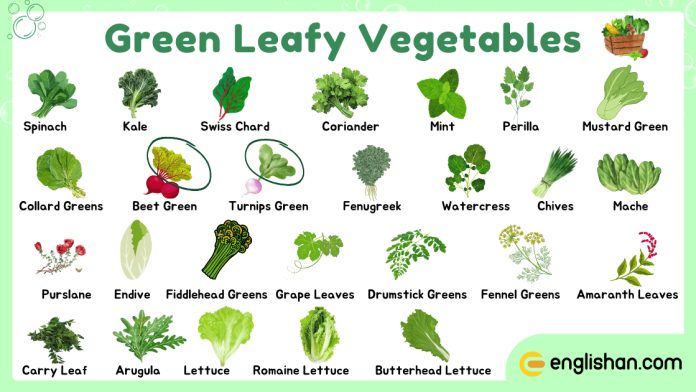Contents
In this blog post, you will learn the names of green leafy vegetables in English. Knowing these names is helpful for building your vocabulary, especially when talking about food and health. Understanding these words can make your conversations clearer and more effective.
To learn more vocabulary on different topics, visit our vocabulary category.
Nutrient-Packed Leafy Greens Names
Spinach
Spinach is a well-known leafy vegetable rich in iron, calcium, and vitamins A, C, and K. It’s available year-round, especially in temperate regions like the United States and Europe. Spinach promotes bone health, supports immune function, and is often included in lists of nutritious green leafy vegetables names.
Kale
Kale is a powerhouse of vitamins A, C, and K, as well as antioxidants and fiber. It grows best in cooler seasons, thriving in countries like the United States, Canada, and Germany. Kale helps reduce inflammation and supports heart health, making it a popular choice in healthy diets.
Swiss Chard
Swiss Chard is packed with vitamins A, C, and K, along with magnesium and iron. It’s available during warmer months, particularly in Mediterranean countries like Italy and Greece. Swiss Chard supports bone health and is excellent for maintaining a healthy digestive system.

Herbs and Aromatic Leafy Green Vegetables
Coriander
Coriander, also known as cilantro, is a herb rich in vitamins A and C, and potassium. It grows well in cooler seasons, particularly in India, Mexico, and Egypt. Coriander aids digestion and detoxifies the body, often included in various global cuisines.
Mint
Mint is a refreshing herb high in vitamin A, iron, and antioxidants. It thrives in temperate regions such as the United States, India, and Morocco. Mint is great for digestion and has calming properties, often used in teas and culinary dishes.
Perilla
Perilla, commonly found in East Asia, is rich in omega-3 fatty acids, vitamins, and minerals. It grows best in summer, especially in Japan, Korea, and China. Perilla supports respiratory health and adds a unique flavor to traditional dishes.
Cruciferous and Hearty Greens
Mustard Green
Mustard Green is a spicy leafy vegetable loaded with vitamins A, C, and K, as well as calcium. It’s mostly grown in cooler climates like those in the United States and Japan. Mustard greens are excellent for bone health and boosting immunity.
Collard Greens
Collard Greens are nutrient-dense, rich in vitamins K, A, and calcium. They are primarily grown in the southern United States, especially during the winter. Collard greens promote heart health and are great for maintaining strong bones.
Cabbage
Cabbage is a versatile vegetable rich in vitamins C and K, along with fiber and antioxidants. It’s available year-round in countries like China, Russia, and the United States. Cabbage supports digestive health and has anti-inflammatory properties.
Unique Leafy Greens with Distinct Flavors
Radicchio
Radicchio is a colorful leafy vegetable high in vitamin K, fiber, and antioxidants. It’s typically grown in Italy, the United States, and France during the cooler seasons. Radicchio supports heart health and adds a bitter yet flavorful note to salads.
Bok Choy
Bok Choy, also known as Chinese cabbage, is rich in vitamins C and K, as well as folate. It’s a cool-season crop, commonly grown in China, Korea, and Japan. Bok Choy helps maintain strong bones and supports immune function, often used in stir-fries.
Sorrel
Sorrel is a tangy leafy green rich in vitamins A, C, and potassium. It grows well in the spring and summer in regions like Europe, Russia, and North America. Sorrel aids digestion and boosts immunity, adding a unique flavor to soups and salads.
Asian Greens and Leafy Herbs
Tat Soi
Tat Soi is a mild, nutrient-rich green loaded with vitamins A, C, and calcium. It grows best in cooler climates like those in China, Japan, and the United States. Tat Soi supports bone health and is often used in Asian cuisines for its delicate flavor.
Mizuna
Mizuna, also known as Japanese mustard greens, is rich in vitamins A and C, and antioxidants. It’s typically grown in cooler seasons in Japan, the United States, and Europe. Mizuna supports eye health and adds a peppery flavor to salads.
Basil
Basil is a fragrant herb full of vitamins A and K, and antioxidants. It’s widely grown in warm climates like Italy, Thailand, and India. Basil supports heart health and has anti-inflammatory properties, making it a staple in Mediterranean and Asian cuisines.
Lettuce Varieties and Salad Greens
Romaine Lettuce
Romaine Lettuce is a crunchy leafy green rich in vitamins A and K, as well as folate. It’s available year-round, particularly in the United States, Canada, and Mexico. Romaine lettuce is one of the common green leafy vegetables names in English, and it supports heart health, making it a popular choice in salads.
Butterhead Lettuce
Butterhead Lettuce, including Bibb and Boston varieties, is soft and rich in vitamins A and K. It grows best in cooler climates like those in Europe and North America. Butterhead lettuce supports bone health and adds a mild flavor to salads.
Red Leaf Lettuce
Red Leaf Lettuce is packed with vitamins A and K, and antioxidants. It’s grown in cooler seasons, especially in Europe and the United States. Red leaf lettuce promotes eye health and adds a vibrant color to dishes.
Other Notable Leafy Greens
Watercress
Watercress is a peppery leafy green rich in vitamins A, C, and calcium. It’s typically grown in the cooler months in the United Kingdom, the United States, and Europe. Watercress supports bone health and is excellent for boosting the immune system.
Malabar Spinach
Malabar Spinach is a heat-loving leafy vegetable high in vitamins A and C, and iron. It thrives in tropical climates like India, Southeast Asia, and Africa. Malabar spinach promotes eye health and is often used in soups and stews.
Pea Shoots
Pea Shoots are tender, nutrient-dense greens rich in vitamins A, C, and K. They’re usually grown in spring and summer in countries like China, the United States, and Canada. Pea shoots support bone health and add a fresh flavor to salads and stir-fries.
Nutritious Green Leafy Vegetables Names for Unique Flavors
Escarole
Escarole is a slightly bitter leafy green rich in vitamins A, C, and folate. It’s primarily grown in cooler seasons in Italy, France, and the United States. Escarole supports digestive health and adds a robust flavor to soups and salads.
Endive
Fiddlehead Greens
Fiddlehead Greens are the young, coiled fronds of ferns, rich in vitamins A, C, and antioxidants. They are typically harvested in the spring in regions like Canada, the United States, and Japan. Fiddleheads are known for their antioxidant properties and support immune health.

Green Leafy Vegetables and Their Uses
|
Salads and Raw Use |
Cooking (Steamed, Stir-fried, etc.) |
Herbs and Garnishes |
Unique or Specialty Greens |
|
Lettuce |
Kale |
Coriander |
Purslane |
|
Romaine Lettuce |
Swiss Chard |
Mint |
Endive |
|
Butterhead Lettuce |
Mustard Greens |
Perilla |
Fiddlehead Greens |
|
Iceberg Lettuce |
Collard Greens |
Fenugreek (Methi) |
Grape Leaves |
|
Arugula |
Beet Greens |
Watercress |
Drumstick Greens |
|
Spinach |
Turnip Greens |
Chives |
Amaranth Leaves |
|
Mache |
Bok Choy |
Fennel Greens |
Escarole |
|
Cress |
Tatsoi |
Basil |
Dandelion Greens |
|
Sorrel |
Mizuna |
Curry Leaf |
Chicory |
|
Spinach Beet |
Radicchio |
||
|
Malabar Spinach |
|||
|
Broccoli Rabe |
|||
|
Pea Shoots |
Amaranth Leaves
Amaranth Leaves are nutrient-dense, packed with vitamins A, C, and iron. They grow in warm climates like India, Africa, and South America. These leaves are excellent for boosting immunity and promoting eye health, making them a popular addition to many traditional dishes.
Chives
Chives are slender, green herbs rich in vitamins A and K, along with antioxidants. They grow well in spring and summer, particularly in Europe, Asia, and North America. Chives support immune function and are known for their anti-inflammatory properties, often used as a garnish.
Carry Leaf (Curry Leaf)
Curry Leaf is a fragrant herb rich in vitamins A, B, and C, along with calcium. Among the green leafy vegetables names in English, curry leaf stands out, primarily grown in India, Sri Lanka, and Southeast Asia. Curry leaves are known for their digestive benefits and are widely used in Indian cuisine for their distinct flavor.
Mache
Mache, also known as lamb’s lettuce, is a tender green rich in vitamins A, C, and iron. It grows well in cooler seasons, especially in France, Italy, and Germany. Mache supports immune health and is often used in salads for its mild, nutty flavor.
Sorrel (Red Veined Sorrel)
Sorrel is a tangy leafy green rich in vitamins A, C, and potassium. It grows well in the spring and summer in regions like Europe, Russia, and North America. Sorrel aids digestion and boosts immunity, adding a unique flavor to soups and salads.
Methi (Fenugreek Leaves)
Methi, or Fenugreek Leaves, are rich in iron, magnesium, and fiber. They are grown in regions like India, Egypt, and Morocco, particularly during cooler seasons. Fenugreek helps regulate blood sugar and improves digestion, often used in traditional medicine.
Tat Soi
Tat Soi is a mild, nutrient-rich green loaded with vitamins A, C, and calcium. It grows best in cooler climates like those in China, Japan, and the United States. Tat Soi supports bone health and is often used in Asian cuisines for its delicate flavor.
FAQs:
Green leafy vegetables are healthy and full of nutrients! Here are some simple examples:
Spinach
Kale
Lettuce
Swiss chard
Collard greens
Mustard greens
Arugula
Bok choy
Watercress
You can use these in salads, stir-fries, or soups to make your meals healthier and tastier!
Here areof the best leafy greens:
1. Spinach
2. Kale
3. Swiss chard
4. Arugula
5. Collard greens
These are healthy, tasty, and easy to add to salads, soups, or stir-fries!
A leafy vegetable that starts with B is bok choy. It’s a type of Chinese cabbage that’s great for stir-fries, soups, or steaming!
The “king” of leafy vegetables is often considered to be kale because it’s packed with nutrients. Kale is rich in vitamins A, C, and K, along with antioxidants, calcium, and fiber. It’s super healthy and versatile, making it a popular choice for salads, smoothies, and cooked dishes!
A leafy vegetable that starts with K is kale. It’s super nutritious and can be used in salads, soups, or smoothies!
You May Also Like






